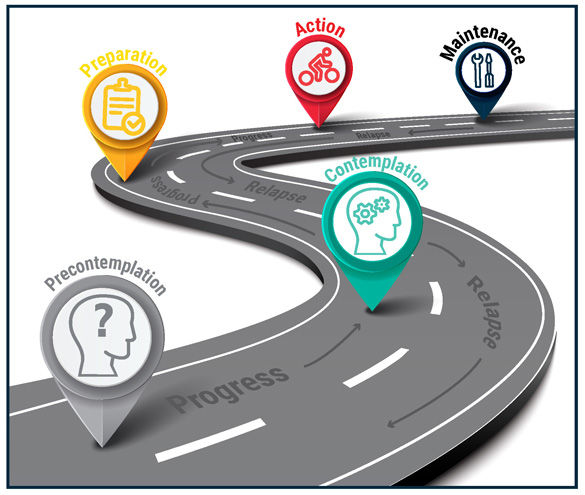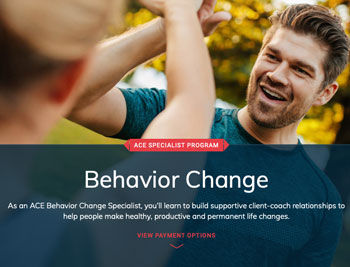
The primary desire we have as health and fitness professionals is that our clients make steady, forward progress toward their intended goals, be that weight loss, improved energy levels, better sleep quality or enhanced overall well-being. To guide our clients in their quest for improvement and self-growth, we know we must focus on the behaviors that ultimately influence a client’s progress or, the opposite, a client’s regression. Focusing on the behaviors is effectively accomplished by coaching clients to discover their own potential versus directing or telling them what to do.
In simplified terms, this intentional and guiding effort is called health coaching. If you find yourself motivated to take a more comprehensive approach with your fitness clients, consider taking these active steps to enrich the experiences your clients have with you as their personal trainer.

A health coach is a unique member of the allied healthcare continuum, as well as of he health and fitness industry. As such, obtaining an accredited health-coaching certification is a necessary first step. A health coach is a professional who employs a client-centered approach in an effort to guide clients toward lasting lifestyle changes that are aligned with the client’s values and needs. In other words, the health coach is not the expert on the client. Rather, the health coach strives to honor the belief that clients are the expert on themselves and each person has the potential to ignite their own change with intentional guidance and gentle encouragement.
A health coach employs a guidance (questioning and conversing) approach instead of a directed (pointed and telling) approach with clients. As described in The Professional’s Guide to Health and Wellness Coaching, the health coach serves in the role of a “guide on the side, in which clients are supported and encouraged in their own self-discovery and self-directed action.” This is in contrast to the role of a personal trainer. A certified personal trainer, also taking a client-centered approach, focuses more so on developing and implementing personalized exercise programs that improve fitness and overall well-being.
The real value in health coaching is the focus on the conversation and the client–coach relationship, not on the specific physical changes a client wants or needs to make to improve health metrics.

After earning a certification, it’s time to revisit previously defined business goals and determine how best to move forward. Adding health coaching to an existing fitness business may require changes and/or provide new opportunities for career advancement. Consider the following questions when reimagining your current approach to your existing fitness business.
- What are the career opportunities available now that you are a certified health coach? Entrepreneurial? Public? Private?
- What type of structure do you want for a coaching business? Face-to-face, virtual, group, clinical coaching, etc.?
- What additional (if any) insurance do you need?
- Do existing waivers, forms and contracts require changes? What new forms need to be developed and implemented?
- What additional marketing strategies may be useful? And what updates need to be made to your website and email signature?
This isn’t an exhaustive list of business-related questions, but they reflect important issues worthy of contemplation. Current exercise professionals interested in enhancing their fitness business with health coaching services must be thoughtful and intentional and, above all else, mindful of the changes required to establish their creditability in the health-coaching industry.

When clients seek the services of a personal trainer, they often come with a loosely defined goal or general idea of what type of outcome they want to achieve. These various “goals” range from weight loss (the number-one identified reason for seeking a personal trainer), improved muscle definition, enhanced strength or general aesthetic desires. While there are other outcomes clients seek, most are weight or appearance centered. While these types of outcomes are not “wrong” or “bad,” they are what we identify as product or outcome-based goals versus a process goal (one that focuses on behavior change).
When it comes to helping clients identify their true motivations and goals, health coaches use the GROW model. This model provides a framework for setting goals that is focused on valued and autonomous behavior changes that ultimately translate into action plans for the client. The acronym GROW stands for goal, reality, options and will. Here is a brief summary of each step:
Goal: This step is aimed at supporting the client as they establish a behavior-change (or process) goal. At this point, the health coach uses open-ended questions to help uncover the client’s why and determine the client’s stage of change based on the transtheoretical model of behavior change (Figure 1). Examples of questions asked at this stage are:
- What do you want to achieve?
- What is important about this achievement?

Reality: Here, the health coach helps the client explore their current situation and what factors may impact the goal. Again, open-ended questioning is used. Questions asked at this stage may include:
- What steps have you taken toward your goal?
- What is happening now in your life?
Options: At this step, the health coach and client engage in brainstorming a list of possible options the client could use to achieve their stated goal(s). Clients also consider the potential stumbling blocks they may encounter along the way. Open-ended questions to consider for exploring options might be:
- What are possible obstacles in achieving this goal?
- What have you done in the past that was successful?
Will: In this step, clients formulate more specific and solid action plans (with guidance from the health coach). The coach, as always, uses open-ended questions to guide the conversation and encourage the client to “dig deeper” to reveal more telling information. Questions a health coach might ask a client in this step may be:
- What will you do now?
- How will you move forward?
Note: Exclusive for ACE Certified Professionals, the link at the top of the page features a more thorough explanation of the transtheoretical model of behavior change and how to use it with clients. In addition, the GROW model and its practical application is discussed in greater detail.

Rapport is the foundation of any solid and successful relationship. ACE Certified Personal Trainers are already well-versed in developing and enhancing rapport, as it is one of the guiding principles of a thriving client-centered approach to personal training utilizing the ACE Integrated Fitness Training® Model, along with empathy and trust. The same is true for the health coaching experience. Rapport is paramount to successful coaching.
From the time you first meet with a potential client, focus on establishing and building rapport. This means paying close attention to verbal and nonverbal behaviors and mirroring the client’s voice volume, speaking pace and body language. Doing so communicates to the client that you are engaged and focused on the conversation and are prepared to be mindful of the client’s needs.
The most interesting (and perhaps the most complex) aspect of rapport is that it is a process rather than an isolated occurrence. As you and your clients work together, rapport should be prioritized and nurtured.
Each client session should lead off with rapport-building efforts. Begin by engaging the client in a conversation about how they are doing, follow-up with them if they mentioned something significant in the previous session (such as their child’s recital or a birthday party), make direct eye contact, listen empathetically and actively with the intent to understand and not the intent to reply, and express interest in them as a whole person and not just a client. The more you get to know your clients, the easier it will be to find new ways to connect with them on a deeper level.

Motivational interviewing (MI) is a client-centered conversation style of communication with the primary purpose of supporting, encouraging and facilitating a client’s desire to change their behavior. This process takes a less directive (or telling) approach to communication and instead employs a guiding style. The health coach works to awaken the potential in a client versus telling the client “this is what you need to do to accomplish X.”
The use of MI is shown to be highly effective for those clients who may be ambivalent to change. As we know, behavior change is a challenge for most individuals. It takes time to unlearn habits and develop new ones, so many clients you encounter will express some ambivalence because of the difficult nature of change as a commitment and process.
Because MI is one of the primary underpinnings of the coaching process, exercise professionals wishing to take a more refined “coach approach” can benefit from engaging in continuing education opportunities specifically focused on learning about MI and its core tenets and use. Of course, it is equally critical to practice employing those skills in daily conversations with clients. Just like behavior change, it takes time to develop sophisticated MI skills and master the competencies. Be patient in the journey.

Providing instruction and directed recommendations is a common approach for health and exercise professionals. Simplified examples of directed guidance commonly dispensed include:
- “You noted your stress levels being extremely high this past month. I want you to meditate for 15 minutes each day.”
- “In your last food log, I noticed you had 5 cups of coffee and minimal water on three days of the week. I suggest you reduce your intake of coffee to 3 cups and drink at least 64 ounces of water daily.”
Because directed advice (telling) is commonplace, professionals have a natural tendency to eagerly and immediately offer advice and solutions for clients. This advice-giving mindset is well-intended but ultimately less effective for eliciting change in clients. This tendency is known as the “righting reflex” and its use is often counterproductive and results in the exact opposite of progress. This is, of course, a less-than-ideal outcome for clients or the goal of health coaching.
The most effective way to motivate a client and engage them in the process of sustainable change is to avoid arguing with them or forcing them down the “right” path by telling them what to do. “If you are arguing for a change and your client is arguing against it,” write Miller and Rollnick, in their landmark Motivational Interviewing: Preparing People to Change, “you’ve got it exactly backward.”
Instead of employing the “righting reflex,” go back to steps 3 and 5 and engage in the motivational interviewing process to encourage clients to uncover answers and develop their own solutions to the concerns they wish to confront.
Conclusion
Incorporating health coaching into your exercise business enables you to take a more holistic and comprehensive approach to training clients. It’s not only about the physical dimension of wellness or achieving some weight-centered or physique-related outcome. Infusing health coaching into fitness is ultimately about supporting positive and sustainable lifestyle change that reaches across all dimensions of a client’s life. A health-coaching experience offers clients a unique opportunity to achieve intentional harmony and a mindful life balance in addition to improved health-related outcomes.





 by
by 












